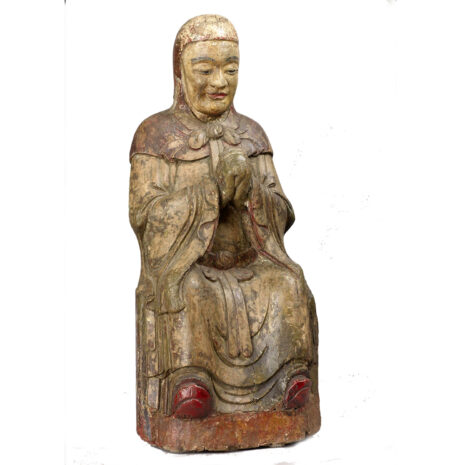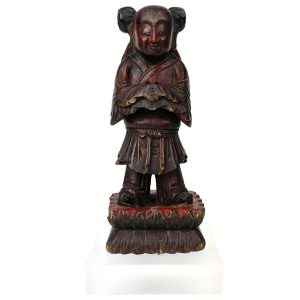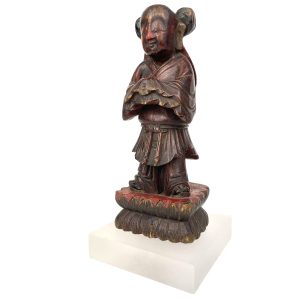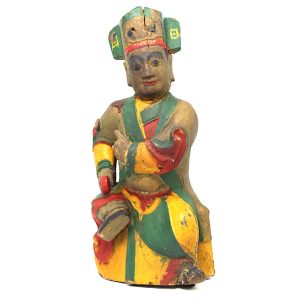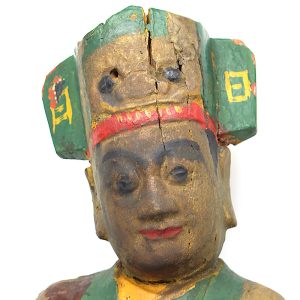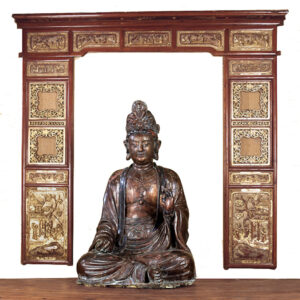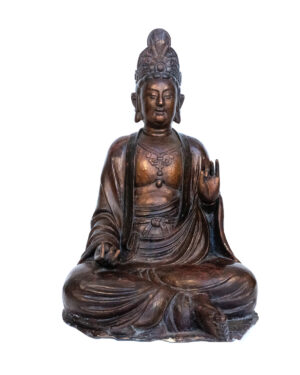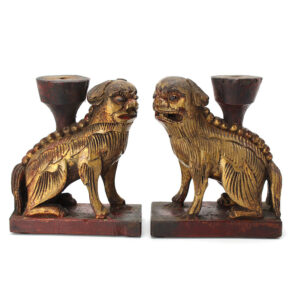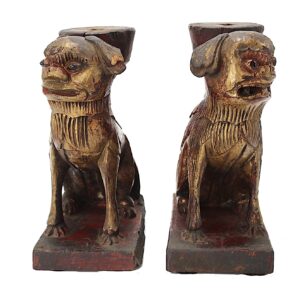Antique Rare Large Lohan with Hands in Reverence, China (16436A-WHKE)
H: 28.25 W: 12.75” D: 9.75” | FOR SHIPPING and pricing INFORMATION CONTACT US AT 213-568-3030
Although a Buddhist image, as a lohan this carving is portrayed as a real person with very individual, distinctive, and un-idealized features. His benevolent youthful face sweetly smiling face with downcast eyes is an image of compassion, wisdom and peace.This exceptional, beautifully crafted rare 17-18th century Ming/Qing large Lohan is from the same Buddhist site as the foreign-born heavy bearded Lohan Bodhidharma, and the same artist may have carved both. We recommend displaying them together.
Description
Lohans are the only enlightened Buddhist beings that were allowed to be portrayed realistically rather than as idealized representations. This beautifully crafted antique and very rare large image looks like a portrait of a real person with very individual, distinctive, and un-idealized features. His eyebrows curve above a wide triangular nose with well pronounced cheekbones, chin and jaw bone. His high backless throne has space below for his feet wearing monk’s red slippers. His monk’s robes with a hooded garment draped over his shoulders and tied under his chin are well defined, as are his belt, material draped between his legs, and wavelike creases of his robes at the arms, elbows, knees, shoulders, legs and elsewhere. His gracefully bent arms are lifted to his chest with hands clasped in reverence. His masterfully carved face captures the visage of an enlightened contemplative, serene and spiritual being with unique facial features. Early Chinese Mahayana statues portrayed Lohans as living in the human world in human forms. They achieved enlightenment spiritual practices and asceticism, and were no longer subject to rebirths in samsara cycle but choose to not enter nirvana and remain as guardians to preserve Buddhist teachings and protect the Buddhist faith. During the Ming and Qing dynasties these statues tended to reflect local practices and physical and cultural characteristics in daily Chinese lives and some, like this reflected the syncretic blending of Buddhism, Taoism, Popular Religion traditions and Chinese legends as well as a shift from religious to a secular orientation. Their depictions also changed to absorb traits of Taoist immortals: sages with magical powers, perfect knowledge of all things including the nature and the secrets of immortality who could elicit perfection in others. Lohan statues only appear along the walls of Buddhist temples and legends and portrayals continually evolved among dynasties and regions. This Lohan is from the same Buddhist temple as the heavy bearded Bodhidharma, Lohan (16436B-WHKE), and the same artist may have carved both.
Click here for the Blog Consecrating Wooden Images to Imbue Them with A Life Force
Additional information
| Place of Origin | China |
|---|---|
| Period | Antique, Ming/Qing Dynasties |
| Date | 17-18th Century |
| Materials and Technique | Wood |
| Dimensions (inches) | Ht: 28.25” W: 12.75” D: 9.75” |
| Dimensions (metric) | Ht: 71.75cm W: 32.38cm D: 24.76cm |
| Condition | Excellent, age appropriate signs of wear |
| Item Number | 16436A-WHKE |
| Shipping Box Size | This item is oversized. Call 213-568-3030 for shipping cost. |
